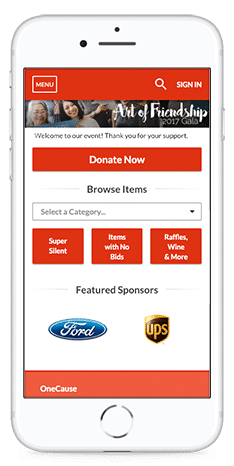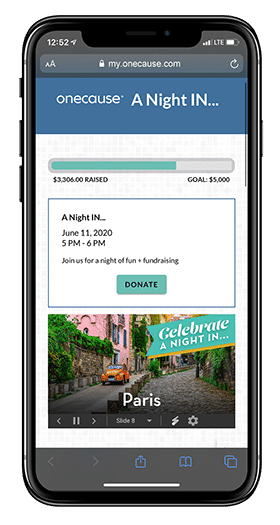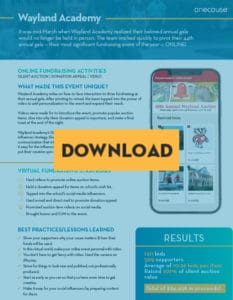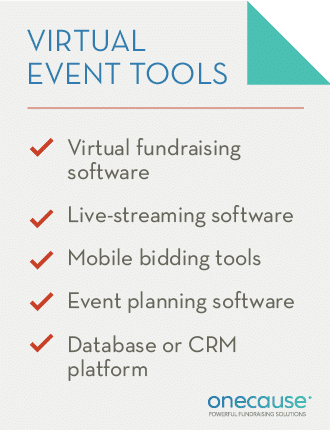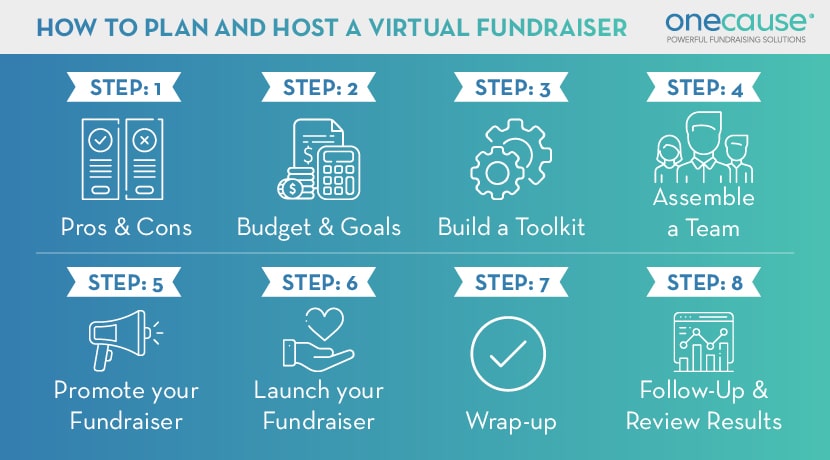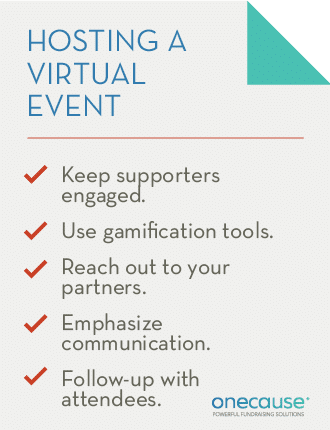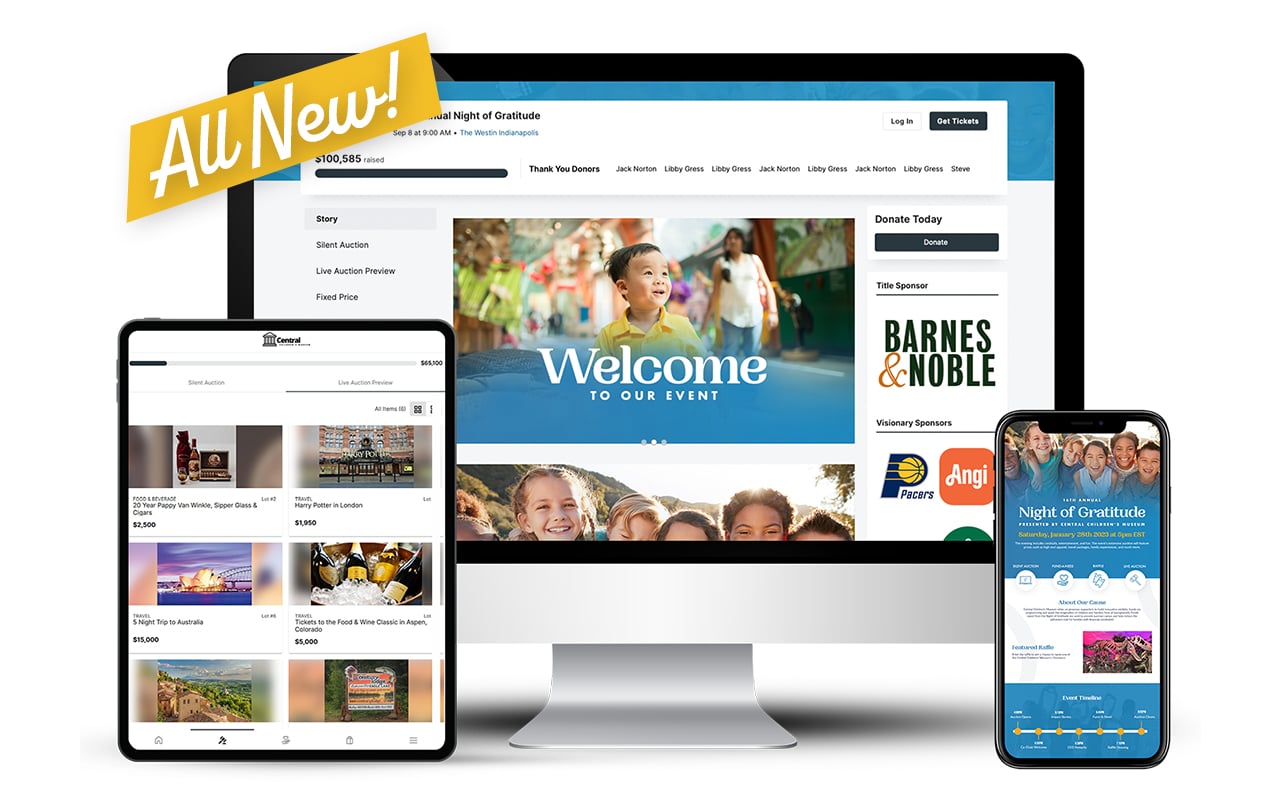Virtual Fundraising Events: Complete Guide for Nonprofits
Virtual fundraising events are a huge new trend for nonprofits. Whether you’re planning a virtual event in reaction to new challenges or trying to grow your nonprofit’s online footprint, having a concrete plan to keep donors engaged virtually will be critical going forward.
Successful virtual fundraising events come in many shapes and sizes—and their fundraising flexibility enables nonprofits to customize and launch virtual events that fit their unique needs. You know your donor landscape like the back of your hand, so read this guide to find the virtual mold that fits your mission and community best! Here’s what we’ll cover:
Virtual Fundraising Events for Nonprofits
Use the table above to jump to a particular section, or follow along with us from the top. You’ll be planning your next virtual fundraising event in no time! Let’s dive in.
Essentials of Virtual Fundraising Events
If your nonprofit is new to virtual fundraising events, your team probably has a few questions. While many aspects of planning a virtual event are similar to traditional, in-person undertakings, there are several key differences that will impact how you approach your particular event.
For virtual fundraising newbies, here are the essentials to keep in mind as you get started:
Virtual Nonprofit Events FAQ
| What are virtual fundraising events? | Virtual fundraising events are any type of online, interactive opportunity to engage with donors and solicit online donations. Virtual events can take many forms and be adapted for all kinds of missions and goals. Hybrid virtual events are also becoming increasingly popular. |
| How do they work? | Exactly how your virtual fundraising event works will depend on its specific purpose and goals. However, all virtual fundraising events rely on virtual fundraising software to facilitate interactions, accept donations, and present live-streamed video feeds. |
| What are the benefits of virtual fundraising events? | Virtual fundraising events are effective because they offer a high level of flexibility for nonprofits to suit their mission, goals, and community. They're also generally easier and less expensive to plan than major in-person events. Plus, they open up your fundraising event to large audiences that can join in from anywhere! |
| What are the drawbacks of virtual fundraising events? | You'll likely need to invest in new technology to plan and host your first virtual fundraising event. Also, it can be more difficult to keep your audience engaged virtually than it would be in-person. Tech investments are worthwhile if you'll host more virtual events, and the right strategies can help keep your audience tuned in. |
| Which nonprofits can host virtual events? | Any nonprofit can host a virtual fundraising event! Developments in virtual fundraising tech have made online-only events more accessible for nonprofits of all sizes. Plus, virtual events are naturally flexible, making it easy to adapt your plans to the proper scale for your audience and budget. |
We’ll cover different types of virtual fundraising events below, but the biggest point to keep in mind is that virtual events are extremely flexible.
You can host a classic event or develop your own virtual program that incorporates various elements of live-streamed galas and celebrations, online auctions, peer-to-peer challenges, virtual walkathons, and more.
Virtual fundraising had become especially important during the COVID-19 pandemic and social distancing guidelines. However, the shift towards online-centric fundraising strategies has been occurring for several years now. If your organization is new to the concept of virtual fundraising, check out our complete guide to virtual fundraising to get started.
Virtual Fundraising Event Ideas
Virtual fundraising events come in all shapes and sizes! There are plenty of ways to adapt your event with various fundraising opportunities and ways for supporters to get involved.
Here are a few of our favorite ideas for virtual fundraising events:
1. Virtual Auctions
Taking your nonprofit’s charity auction online has a few major benefits. These virtual events are highly flexible, engaging for audiences, and typically less resource-intensive to plan than in-person auctions.
You’ll need the perfect range of auction items, mobile bidding tools, and a plan for spreading the word to donors. Bonus points if you combine your virtual auction with additional live-streamed events or peer-to-peer fundraising elements!
Check out our complete guide to online charity auctions for a comprehensive breakdown of these virtual events.
2. Virtual Galas
Adapt your annual gala to take place virtually! Virtual galas and other live celebrations bring supporters together for an interactive program that highlights your mission and asks for support.
Use live-streaming software and virtual fundraising tools to plan and host your gala. Schedule a complete program of ceremonies, speakers, videos, live appeals, and more to keep attendees engaged. Incorporating a virtual auction is never a bad idea, either!
Check out the OneCause virtual event center to learn more about the virtual gala experience.
3. Virtual Walks & Runs
Even charity walks and runs can be adapted as virtual fundraising events! Launch a peer-to-peer campaign for participants to secure support before the event, then schedule a series of challenges for them to complete remotely. Check out our top peer-to-peer virtual fundraising tips to get started planning your virtual event.
4. Viewing Parties
This is a low-key but effective way to engage donors with a virtual fundraising event. Find a documentary or another film related to your mission (or produce your own video content!) and host a virtual viewing party. Ask for a voluntary donations when attendees sign up, and make live appeals during follow-up group discussions.
5. Virtual Happy Hours
Using virtual fundraising software, launch an online event center for donors to join a virtual happy hour. Plan a loose schedule of discussion topics (and a suggested drink list) and invite donors to register in advance. This simple event can help raise funds and strengthen relationships with donors.
Bonus! For more virtual event and campaign ideas, check out our comprehensive list, 20+ Virtual Fundraising Ideas to Reach Donors in COVID-19 & Beyond.
Online Fundraising Event Success Stories
Nonprofit organizations of all sizes have seen amazing results from their virtual fundraising events. Whether you’re pivoting existing plans for in-person events or are planning them virtually from the start, learning from others’ wins is always a smart strategy.
Here are three success stories from organizations that used virtual fundraising software from OneCause to engage donors and exceed their fundraising goals:
Boys & Girls Club of Greater Washington
Faced with the challenge of pivoting their annual “Blue Fest” fundraising campaign to take place virtually, the Boys & Girls Club of Greater Washington got creative.
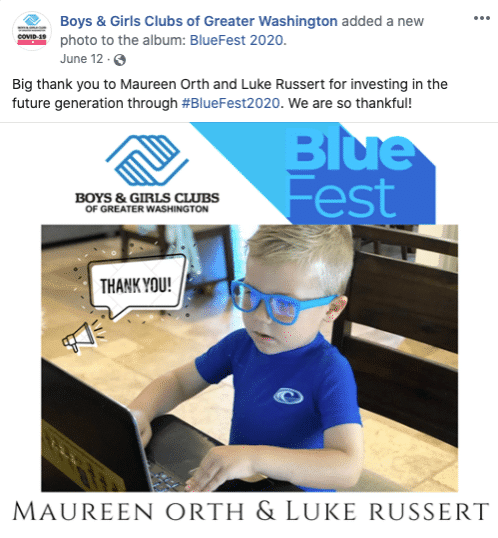
The solution? Not just a one-day virtual event, but a three-day virtual fundraising experience.
Incorporating a wide variety of interactive elements, live-streamed programs and receptions, online auctions, and live donation appeals, the Boys & Girls Club organized an extremely engaging virtual event. The results speak for themselves:
- 500+ live-stream attendees
- Raised 110% of their silent auction items’ total value
- Generated 173% of their live donation appeal goal
- Raised an incredible whopping total of $150,896
Check out the complete Boys & Girls Club success story for a full breakdown of their three-day strategy.
Interfaith Food Pantry
With food pantries and other community services more important than ever, the Interfaith Food Pantry moved fast in the early weeks of the COVID-19 pandemic to pivot their annual fundraising gala to take place virtually.
Using a combination of virtual auction elements, behind-the-scenes live-streams, and engaging social media strategies, their online extravaganza exceeded their fundraising goals.
Interfaith Food Pantry used one online auction tactic to particularly great effect: fixed-price item sales. Giving donors the option to simply purchase fixed-price items to be donated (like cases of peanut butter and soup) was a fantastic success. All of their fixed-price food packages sold out by the event’s end. Their virtual gala had some incredible results:
- 922 total attendees
- 760 total bids on their virtual auction items
- $13,890 generated through raffle ticket sales
- $32,790 generated through donation appeals
Read the entire Interfaith Food Pantry success story to learn from their successful strategies.
Wayland Academy
A private school based in Wisconsin, Wayland Academy knew they’d need to act fast in order to shift their annual gala to a virtual event.
With virtual fundraising software, personalized videos, and an online auction, they successfully made the move, shattering their expectations for the first-ever virtual event in the process.
As a school fundraising event, the team at Wayland Academy had to ensure their virtual activities were engaging enough to attract busy families. The answer? Exciting video and social media tactics.
Their social influencer strategy was particularly successful. By creating videos, memes, and other pre-written posts ready to be shared online, Wayland Academy tapped into their students’ social media savvy. This generated plenty of buzz for the event, and it freed up the Wayland team’s time to focus on refining other elements of their plans.
Check out these final results:
- 500+ total participants
- An average of 10.26 bids per auction item
- 207% raised of the total value of their auction items
- An amazing fundraising total of $94,456
Read the full Wayland Academy success story to learn more about their strategies and watch the promotional videos they created for their virtual event.
Check out the complete library of OneCause success stories for even more examples of effective virtual fundraising events.
Remember, you don’t have to reinvent the wheel with your next virtual event! Learn from the tactics that helped other organizations reach their goals, and then adapt them for your unique audience.
Tools for Virtual Fundraising Events
So you’re ready to dive into your next virtual fundraising event. Excellent! Before digging into the specifics of planning your event, it’s important to take a look at your nonprofit’s tech stack (especially if this will be your first virtual event).
Virtual fundraising events naturally require a different set of tools than traditional, in-person events.
While event planning software and registration tools will still be useful, you’ll likely need one or more new platforms to help facilitate the event itself. Let’s walk through common types of software that nonprofits use to plan and host their virtual events:
Virtual Fundraising Software
Working with virtual fundraising software provides a more streamlined experience for your team and a more enjoyable event for your donors. Rather than piecing together a system of separate tools, dedicated virtual fundraising software can serve as the central hub for your event.
Platforms like OneCause help you centralize every aspect of your event, from its website to virtual auctions to live-streams. With an intuitive virtual event center, your donors can focus on supporting your mission instead of navigating multiple, confusing platforms.
Live-Streaming Software
Live video feeds are an extremely effective way to engage donors during your virtual events. Any virtual fundraising event can be improved with live-streamed festivities or appeals, so explore your software options early. Don’t forget the cameras, too!
Comprehensive virtual fundraising software will include built-in live-streaming capabilities. For small-scale virtual gatherings, platforms like Zoom can work, as well. However, larger events will benefit from a more immersive, branded live-streaming experience.
Mobile Bidding Tools
For virtual fundraising events that include online auctions, mobile bidding tools are a must!
Ideally, your virtual fundraising software will make it easy to incorporate mobile bidding into the donor experience. Centralizing your virtual event as much as possible will ultimately drive more engagement (and bids).
Event Planning Software
To plan the finer details of your virtual event, you’ll need event planning software.
A comprehensive virtual fundraising platform will help you handle logistical tasks like registrations and building contact lists for marketing. The ability to recruit and manage ambassadors to promote your event is another top feature to look for.
Database or CRM Platform
Your nonprofit’s database will be essential for planning and hosting virtual fundraising events.
Use your database to help you research your audience during the planning process, and then ensure all new engagement data is automatically reported throughout your event. Virtual fundraising software that integrates with your database will be invaluable!
Planning a Virtual Fundraising Event: 8 Steps
Once you have an idea of what your nonprofit’s next virtual fundraising event might be, it’s time to start planning!
The exact planning process that you follow will vary based on the type of event you’re hosting, its scale and goals, and the timeframe you’re working with. While all plans will look a bit different, there are a few core steps you’ll encounter no matter the event:
We walk through each of these steps in greater detail in our general guide to virtual fundraising, but here are the essentials to keep in mind:
- Evaluate pros & cons. Make sure that now’s the right time to jump into virtual fundraising. While virtual events are extremely flexible and can be adapted for any budget, there are a number of different circumstances that might affect your decision.
- Set a budget and goals. Determining these guidelines early in the process will keep your plans focused from start to finish. Begin by setting a budget, including any new tech you’ll need, and then specific revenue and engagement goals for your virtual event.
- Build your toolkit. For your first virtual fundraising event, you’ll need to invest in new software to help plan and host it. If you’ve already hosted one or more virtual events, take some time to review your toolkit and fill any gaps.
- Assemble your team. Don’t try to tackle the entire event on your own! Form a team of staff and volunteers, and designate specific responsibilities like technology, marketing, sponsorships, and auction item procurement to different team members.
- Promote your event. For your virtual event to succeed, it has to stand out online. Donors need to know about your event, how to sign up, and what to expect on the big day. Get them excited with promotions via email, social media, and peer-to-peer tactics.
- Launch your virtual fundraising event. Time to kick off your event! Make sure each team member’s day-of responsibilities are clearly outlined. Have a staff member on hand to answer questions and troubleshoot tech challenges.
- Wrap up your event. Conclude your virtual fundraising event with a grand finale, and consider any elements that will need to be manually closed out. When possible, use software that automatically closes bidding and processes payments.
- Follow-up with donors. After any fundraising event, following up is critical. Express your gratitude to everyone who attended and donated, and begin studying your engagement data for ways to improve your next virtual event!
To walk through each of these steps in greater detail, check out this section of our guide to virtual fundraising.
Tips for Hosting Your Virtual Fundraising Event
When your virtual fundraising event is underway, there are several additional steps you should take to maximize its impact. These tips will help you boost engagement and drive more long-term value from all your hard work. Here’s what we recommend:
- Keep supporters fully engaged throughout your virtual event. Unlike in-person events, it’s all too easy to tune out of a live-streamed event or multi-day virtual activities. Make sure your attendees stay engaged by incorporating plenty of interactive elements, using compelling multimedia, and fostering plenty of communication.
- Use gamification tools. Speaking of boosting engagement, gamification is an extremely effective way to ensure donors stay excited throughout the event. Fundraising thermometers, auction leaderboards, and ambassador contests and awards ceremonies can all boost your event’s energy and drive stronger fundraising results.
- Reach out to your organization’s partners. Be sure to make full use of your nonprofit’s network of partners and sponsors! Businesses and other organizations can help broadcast your event to their own audiences, and sponsors can provide invaluable support and donated auction items to strengthen your entire virtual event.
- Emphasize communication before and during your event. Communication is key before, during, and after a virtual fundraising event. For instance, if you’ll be using new technology, make sure your donors understand how the event will work before launch day. Then, use live-streamed and text message communication to keep them in the loop during your event.
- Follow-up with attendees to drive long-term engagement. After your event ends, immediately follow-up with donors to thank them for their support and offer more ways to stay engaged. You might even take the opportunity to invite them to your next virtual event! Consider sending event surveys, as well, to generate more insights on your event’s strengths and areas for improvement.
Want more tips for hosting an engaging virtual fundraising event? These 10 tips for virtual fundraising success will help ensure your next event hits its goals!
Get Started with OneCause
Successful fundraisers require powerful fundraising software! The OneCause Fundraising Platform makes giving modern, flexible, and seamless to drive deeper engagement and grow your fundraising. Take a look at this versatile all-in-one fundraising software that meets the expectations of today’s donor, supporting any event, in-person, virtual, or hybrid.
Wrapping Up
Virtual fundraising events will be an important part of nonprofits’ strategies going forward. Whether as full replacements for in-person events or as modern, hybrid engagement opportunities, virtual tactics give organizations an unprecedented level of flexibility. Plus, they give donors the ability to join in from anywhere!
With the right technology and strategies on your side, your nonprofit can begin building out an exciting calendar of virtual events to secure more support in COVID-19 and beyond.
But don’t stop here! Keep learning about virtual fundraising with these additional resources:
- 20+ Virtual Fundraising Ideas to Reach Donors in COVID-19 & Beyond. Ready to brainstorm your next virtual event or campaign? We’ve got you covered with these winning ideas.
- Virtual Peer-to-Peer Fundraising Best Practices. P2P fundraising is a natural addition to virtual fundraising campaigns. Learn more with our recommended best practices.
- Virtual Fundraising Resource Center: Nonprofit Examples. Want to see more examples of successful virtual fundraising campaigns? Check out our library of virtual campaigns and events we’ve helped to launch.


